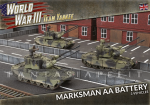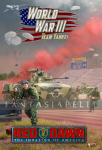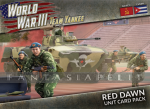World War III: Soviet is our third updated book for World War III: Team Yankee. It features all the great options and units that were in Red Thunder, but with the addition of lots more Formations and Units. World War III: Soviet expands and enhances the forces available in Red Thunder for the Soviet Army.
Inside you will find:
* Background on the Group of Soviet Forces in Germany, 2nd Guards Tank Army, 94th Guards Motor Rifle Division, 7th Guards Tank Division, 18th Guards Motor Rifle Division, and Yuri Volkov’s Tank Battalion.
* Instructions on how to build a T-80 Tank Battalion, T-64 Tank Battalion, T-72 Tank Battalion, T-62M Tank Battalion, T-55AM Tank Battalion, BMP Motor Rifle Battalion, BTR-60 Motor Rifle Battalion, Afgantsy Air Assault Battalion, or a T-80 Shock Tank Company.
* Three Scenarios to test your skills with your Soviet force.
What is Different?
There is more choice. More tank options with the introduction of the T-80, T-62M, T-55AM, and more Motor Rifle options with the BMP-3. These add more Formations to choose from with the addition of the T-80 Tank Battalion, T-62M Tank Battalion, and T-55AM Tank Battalion, as well as the elite veteran T-80 Shock Tank Company
There are a bunch more new formation and support Units and vehicles as well. The 2S6 Tunguska AA Platoon, the BMP-3 Recon Platoon, BMP-3 Motor Rifle Company, BMP-3 Shock Recon Platoon, BMP Shock Motor Rifle Company, BM-27 Hurricane Rocket Launcher Battery, and TOS-1 Thermobaric Rocket Launcher Battery.
Don’t worry, all your old favourites are still available. In fact these can also gain access to the new anti-tank, anti-aircraft, motor rifle, and recon options. You can still take a T-64 or T-72 Tank Battalion, or a BMP Motor Rifle Battalion, or an Afgantsy Air Assault Battalion.
What's New?
As mentioned above World War III: Soviet introduces a bunch of new Soviet vehicles. The two stars of this line-up are the T-80 tank and BMP-3 infantry fighting vehicle, both brand new plastic models. The T-80 takes the next step beyond the T-64 and T-72. The T-80 introduced in World War III: Soviet is the T-80U with its explosive reactive armour (ERA) giving it a distinct look that sets it apart from the other Soviet tanks. This ERA armour is more that cosmetic, it also enhances its protection against HEAT weapons as well as improving its armour against kinetic energy penetrator like those fired from other tanks. This gives it Front armour 20 and side 10, while the ERA gives it 16 versus HEAT weapon on the side. No pesky LAW or Panzerfaust is going to bother this tank. It is armed with the same powerful 125mm 2A46 smooth-bore gun as the T-64 and T-72, and like the T-64 it fire an excellent anti-tank missile for extended range. The T-80’s AT-11 Sniper missile can hit targets out to 48”/120cm with anti-tank 22. The gun is fully stabilised and allows the gun and missile to be fired on the move. It also has a Tandem Warhead which means it ignores ERA armour.
T-80 Shock Rifle Company represents an elite unit with a higher focus on training. They are Hit On 4+, have a Skill of 3+, while maintaining the excellent Courage, Morale and Remount/Rally of other Soviet troops. They are organised in platoons of three T-80 tanks to represent there better tactical flexibility. They also have their own BMP-3 Shock Scout Platoon with equally good ratings as well as the BMP-3 Shock Motor Rifle Company that can be mounted in either the new BMP-3 or the BMP-2.
As well as the above unit the BMP-3 introduces another options for Scout Platoons and Motor Rifle Battalions and Companies. The BMP-3 is more armoured than the BMP-1 or 2, with Front 5, Side 3, and Top 1. It also maintains the good mobility of its predecessors. It can carry two passengers, is Amphibious and it fitted with Infra-red vision equipment. It is armed with low pressure 100mm gun that doubles as a missile launcher. It fires the AT-10 Stabber missile out to 48”/120cm and can be fired on the move. It has an AT of 21 and FP 3+. The 100mm also fires high-explosive rounds out to 24”/60cm with ROF 1/1, AT 5, FP 2+, Brutal, Laser Range Finder, and Stabiliser. For additional firepower against light vehicles it has a co-ax 30mm gun (Range 20”/50cm, ROF 3/2, AT 10, FP 5+).
All the motor rifle companies, whether mounted in a BMP-3, BMP-2, BMP-1, or BTR-60, also gain optional access to the RPG-7VR to replace their RPG-7s. The RPG-7VR has a shorter range by packs a more powerful punch (Range 8”/20cm, ROF 1/1, AT 19, FP 2+, Assault 6, HEAT, Slow Firing, Tandem Warhead).
As a replacement for the aging ZSU-23-4 Shilka the Soviets designed the 2S6 Tunguska. It is armed with heavier twin 30mm guns giving better range and rate-of-fire (36”/90cm range against aircraft, ROF 7/5). Additionally it is also armed with SA-19 Grendel AA missiles integrated into the same system, giving it an accurate long range option (range 64”/160cm, ROF 2/-, FP 3+)
The second line or reserve tank units in the Soviet Army were armed with older tanks like the T-62M. However, a modernisation program had brought a number of improvement to these old tanks. Improved ammunition give the 115mm 2A20 gun an anti-tank of 21. It also has a Laser Rangefinder some does not suffer a long range penalty To Hit. They can also fire the same AT-10 Stabber Missile as they BMP-3. Thought not quite as tough as the T-72, its armour of Front 14, Side 9, and Top 2 makes it tough opposition for the likes of Leopard 1s, AMX-30s, or M60s.
For those reservists not lucky enough to get a T-62M, there was also the T-55AM. Like the T-55s used by their Warsaw Pact allies, these had been upgraded with improved armour (Front 14, Side 9, Top 2) as well as a Laser Rangefinder and AT-10 Stabber missile for its main gun. The 100mm gun was also had some level of stabilisation (no Slow Firing penalty for moving ROF) and improved ammunition (AT 18).
World War III: Soviet has some new support units. The first of these is the BM-27 Hurricane Rocket Launcher Battery. These have better range, anti-tank, and firepower than the old BM-21 Hail.
The TOS-1 Thermobaric Rocket Launcher is a different beat altogether with its pod of 24 220mm thermobaric rockets mounted on a T-72 tank hull. These rockets’ fiery blast devastates a large area in one volley. It is short ranged for a rocket launcher (48”/120cm), but packs a mighty punch hitting with a big Salvo template with its AUTO firepower and Brutal rating (re-roll Infantry Saves).
Old Favourites
The T-72 is the Soviet Union’s everyman’s tank. Cheaper and less complicated than the T-80 or T-64, it is armed with powerful 125mm gun that packs an excellent anti-tank 22. With Front Armour 16 and BDD (13 against HEAT) it does alright against western tanks, and can dominate the lighter armoured varieties.
The T-64 is a more sophisticated tank than the T-72. It comes with its own optional anti-tank guided missile that is fired through its 125mm 2A46 smooth-bore gun. This allows the tank to fire an Anti-tank 21 missile out to 48”/120cm even on the move. Being a HEAT weapon, enemy targets don’t get an extra +1 to their armour at ranges over 16”/40cm. It is also Guided so doesn’t suffer the addition +1 to the score to hit for long range. Being the same gun as the T-72, the 125mm 2A46 is also powerful with conventional anti-tank rounds with a range 32”/80cm, anti-tank 22, and firepower 2+. The T-64 tank has improved armour with a Front 17, Side 9, and Top 2, making it a challenging proposition for many NATO tanks.
If you are not looking for a fancy ride like the BMP-3 with all its bells and whistles you still can’t go passed the trust BMP-2 with its excellent 30mm gun with ROF 3/2, and anti-tank 10. It is also a pretty good ride for your motor riflemen with good protect and excellent mobility. It can also fire the AT-5 Spandrel missile (AT 21, FP 3+).
For something a bit cheaper, but just as mobile and protected there is the BMP-1. This infantry fighting vehicle is armed with a 73mm gun and an AT-3 Sagger missile (AT 19, FP 3+). Both BMPs can carry two passengers.
The BTR-60 is an 8-wheeled armoured personnel carrier mounting 14.5mm and 7.62mm machine-guns in its small turret. Each BTR-60 can carrier two teams as passengers, who are protected from small arms fire by its Front 1, Side 0, and Top 0 armour. The Motor Rifle units mounted in the BTR-60 also have AT-4 Spigot missile teams because, unlike the BMPs, the BTR-60 doesn’t mount an anti-tank missile team. The AT-4 team has a range 8”/20cm – 40”/100cm, ROF 3, AT 19 and FP 3+ and is HEAT and Guided.
The Storm anti-tank missile carrier mounts an AT-6 Spiral guided anti-tank missile on the MT-LB armoured tractor (the same vehicle that the SA-13 Gopher is based on). The launcher is fitted with one tube, but can be lowered into the hull for reloading. The chassis provides the crew with protection from small arms fire with Front 1, Side 1, and Top 1, so don’t expose the Storm too much. However, the AT-6 is very long range (8”/20cm – 56”/140cm) and powerful (with ROF 1, Anti-tank 23, FP 3+ using the HEAT and Guided rules). The units come in two or three Storms and is available as a support. The Storm now also has options to upgrade to the improved Storm-2 armed with the AT-9 Spiral-2 missile with longer 64”/160cm range, AT 24, and a Tandem Warhead.
A quick mention should be made of the SA-13 Gopher as it is still an excellent anti-aircraft option with its 56”/140cm range, ROF 2/- and FP 4+. As a Guided AA weapon it doesn’t have to worry about being a long range.
Another divisional support anti-aircraft option is the SA-8 Gecko SAM launcher. This big 6-wheeled vehicle is an all-in-one design that mounts the missiles and radar together to allow it to detect, track, and engage target aircraft independently. The SA-8 Gecko AA missile has a massive range of 72”/180cm, giving it coverage of most table tops. It has a Halted ROF 3, a FP 3+ and uses the Guided AA rule which gives it not penalty to hit at over 16”/40cm.
For heavy artillery support World War III: Soviet has the 2S3 Acacia 152mm self-propelled howitzer. The 2S3 Acacia has Front 2, Side 1 and Top 1 armour. It can fire its 152mm howitzer as Artillery (Range: 88”/220cm, AT 4, FP 2+ with Smoke Bombardment), or in direct fire (Range: 16”/40cm, ROF 1, AT 14, FP 1+, and uses the Brutal, HEAT, Slow Firing, and Smoke rules). It also has a third option, firing laser-guided Krasnopol Projectiles (Range: 88”/220cm, Halted ROF 1, AT 4, FP 1+ and uses the Brutal, and Krasnopol Projectiles rules). This works a little differently to the American laser-guided projectiles found in the rulebook.
Krasnopol Projectiles are designed for taking out small ground targets rather than tanks. An Observer Team requests Krasnopol Projectiles rather than a bombardment. Then each weapon in the artillery unit fires a Krasnopol Projectile using the normal shooting rules, except using the Observer Team to determine the Line Of Sight. The unit does not suffer +1 to hit for range over 16”/40cm, Armoured Vehicles use Top Armour for saves, and the target team’s armour is not increased by +1 for being over 16”/40cm away.
There still all the tried and tested units like the ZSU-23-4 Shilka AA Platoon, 2S1 Carnation SP Howitzer Battery, the BM-21 Hail Rocket Launcher Battery, SU-25 Frogfoot Aviation Company, and Mi-24 Hind Assault Helicopter Company.
New But Old Models
Red Thunder introduced the BDRM-2 and its variants to World War III: Team Yankee, but World War III: Soviet introduces these three vehicles as plastic kits!
The first of these is the BRDM-2 scout car. These can be taken in the BRDM-2 Recon Platoon in a unit of two or four either as part of a Formation or as support. Like the BTR-60, the BRDM-2 mounts 14.5mm and 7.62mm machines in a small armoured turret. The vehicle itself is protected from small arms fire with Front 1, Side 0, and Top 0 armour. The vehicle is amphibious and fitted with IR (Infra-red) equipment for night fighting, while the unit uses the Spearhead rule.
The second variant of the BRDM-2 is the Spandrel which mounts an AT-5 Spandrel guided anti-tank missile launcher system instead of the turret. The AT5 Spandrel is a powerful anti-tank missile with a range 8”/20cm – 48”/120cm, ROF 1, AT 21, FP 3+ with the Guided and HEAT special rules. These are available in units of two or three either as part of a Formation or as support
Supplementing the powerful SA-13 Gopher SAM Platoon, is the lighter and cheaper SA-9 Gaskin SAM. This vehicle is based on the BRDM-2 scout car, but mounts a SA-9 anti-aircraft guided missile launcher system on top. It has a 360 degree arc of fire and can shoot aircraft out to 48”/120cm away without penalty for long range. These can either be got as pairs or in fours and are available as part
What About My Old Force?
If you are happy running your Soviet force as it is, it is still a perfectly valid force, no units or options have been invalidated. However, there are plenty of great new options that many of you will find very tempting.
If you’ve been thinking about getting some Soviets, but haven’t dived in, this is the perfect time, there has never been so many different options for fielding the Soviet Army in World War III.
Lots Of Extras
World War III: Soviet is also packed full of other stuff. We also have three Scenarios that can either be played as one off games or as part of a three game campaign. The book also covers the exploits of the 2nd Guards Tank Army, 94th Guards Motor Rifle Division, 7th Guards Tank Division, Major Yuri Volkov’s Tank Battalion, and 18th Guards Motor Rifle Division during World War III, plus lots of other background and technical information. It contains a Soviet painting guide and a product catalogue listing all the models available to field a Soviet force in World War III: Team Yankee, making World War III: Soviet a one stop shop for planning the collection of your force.



























